| ID |
Date |
Author |
Category |
Subject |
Year |
|
253
|
Mon Mar 23 15:48:15 2020 |
Laszlo | Calibration | run105 - Xray90 calib Am241, distance 167.5mm, wrong? | |
Detector: 90
Source: Am241
Distance: 167.5mm
Start time: 15:46:49 23.03.2020
Stop time:
file name: run105_xxxx.lmd
avrg. rate: 610Hz
dead-time: 7.5%
suspiciously not Gaussian shaped peaks --> investigation with oscilloscope |
|
254
|
Mon Mar 23 16:17:58 2020 |
Laszlo | Calibration | run106 - garbage! | |
run106 was clicked by accident, please delete! |
|
255
|
Mon Mar 23 16:21:33 2020 |
Laszlo | Calibration | run107 - Xray90 calib Am241, distance 167.5mm | |
Detector: 90
Source: Am241
Distance: 167.5mm
Start time: 15:46:49 23.03.2020
Stop time: 17:32 23.03.2020
file name: run107_xxxx.lmd
avrg. rate: 610Hz
dead-time: 7%
not Gaussian shaped peaks, after previous investigations with the scope, the scope is disconnected.
Just to mention, in order to improve deadtime the other two Xray dets are disconnected. |
|
256
|
Mon Mar 23 17:32:42 2020 |
Laszlo | Calibration | run108 - Xray90 calib Ba133, distance 167.5mm - high rate - deadtime too high! | |
Detector: 90
Source: Ba133 - strong source
Distance: 167.5mm
Start time: 17:32:11 23.03.2020
Stop time: 17:35:34
file name: run108_xxxx.lmd
avrg. rate: 2.7kHz
dead-time: 26% |
|
257
|
Mon Mar 23 17:40:33 2020 |
Laszlo | Calibration | run109 - Xray90 calib Ba133, distance 167.5mm -low rate | |
Detector: 90
Source: Ba133 - weak source
Distance: 167.5mm
Start time: 17:40:11 23.03.2020
Stop time:
file name: run109_xxxx.lmd
avrg. rate: 170Hz
dead-time: 2% |
|
259
|
Mon Mar 23 18:17:27 2020 |
Laszlo | Calibration | run110 - Xray90 calib Ba133, distance 167.5mm -low rate - LESS NOISE | |
Detector: 90
Source: Ba133 - weak source
Distance: 167.5mm
Start time: 18:14:50 23.03.2020
Stop time:
file name: run110_xxxx.lmd
avrg. rate: 160Hz
dead-time: 2%
Uwe reduced the noise on the 90 degree detector (see previous elog entry) |
|
267
|
Wed Mar 25 14:26:22 2020 |
Laszlo | Calibration | run111 - Xray90 calib Am241, distance 167.5mm - LESS NOISE | |
Detector: 90
Source: 241Am
Distance: 167.5mm
.Start time: ? 23.03.2020
Stop time:
file name: run111_xxxx.lmd
avrg. rate: 444Hz
dead-time: 5%
Uwe reduced the noise on the 90 degree detector (see elog entry) |
|
260
|
Mon Mar 23 19:32:53 2020 |
Laszlo | Calibration | run112 - Xray90 calib Am241, distance 200mm - LESS NOISE | |
Detector: 90
Source: 241Am
Distance: 200mm
Start time: 20:01:43 23.03.2020
Stop time:
file name: run112_xxxx.lmd
avrg. rate: 444Hz
dead-time: 5%
Uwe reduced the noise on the 90 degree detector (see elog entry) |
|
261
|
Mon Mar 23 20:52:37 2020 |
Laszlo | Calibration | run113 - Xray145 calib Am241, distance 305mm - LESS NOISE | |
Detector: 145
Source: 241Am
Distance: 305mm
Start time: 20:01:43 23.03.2020
Stop time: 21:43:34
file name: run113_xxxx.lmd
avrg. rate: 220Hz
dead-time: 2.5%
Uwe reduced the noise on the 145 degree detector as well. |
|
262
|
Mon Mar 23 21:47:40 2020 |
Laszlo | Calibration | run114 - Xray145 calib Ba133, distance 305mm - LESS NOISE | |
Detector: 145
Source: 133Ba - strong source
Distance: 305mm
Start time: 21:47:20 23.03.2020
Stop time: 22:04:06 23.03.2020
file name: run114_xxxx.lmd
avrg. rate: 950Hz
dead-time: 11%
Uwe reduced the noise on the 145 degree detector as well.
During measurement the oscilloscope remained connected! |
|
263
|
Mon Mar 23 22:25:41 2020 |
Laszlo | Calibration | run115 - Xray35 Ba133 d=334mm, Xray90 Lead source, d=167.5mm | |
Simultaneous measurement of Xray35 and Xray90. The dead-time is <3%
Detector: 35
Source: 133Ba - strong source
Distance: 334mm
Detector: 90
Source: Lead source
Distance: 167.5mm: the lead source was measured 3mm width with the source in the middle. Therefore, I set the paper zylinder to ~169mm distance.
Start time: 22:25:22 23.03.2020
Stop time: 00:04:49 24.03.2020
file name: run115_xxxx.lmd
avrg. rate35: 75Hz
avrg. rate90: 55Hz
dead-time: 2%
Uwe reduced the noise on the 145 degree detector as well.
During measurement the oscilloscope remained connected! |
|
264
|
Tue Mar 24 00:11:35 2020 |
Laszlo | Calibration | run116 - Xray35 calib AM241, distance 334mm | |
Detector: 35
Source: 241Am
Distance: 334mm
Start time: 00:11:03 24.03.2020
Stop time: 10:01:4224.03.2020
file name: run116_xxxx.lmd
avrg. rate: 20Hz
dead-time: 0% |
|
123
|
Sat Mar 21 12:06:50 2020 |
Laszlo | General | run61 - SCRAPER moved out | |
we want to see any change on the Silicon count rate, because we will have now also Rutherford scattering. |
|
5
|
Fri Apr 5 05:46:20 2019 |
Jan | DAQ | running DRASI for (p,g) | |
We now have a drasi DAQ running for our (p,g) experiments.
The RIO we have it installed right now is: r4l-58
It shall be used with the user <litv-exp>
The DAQ-controle shall be done from lxg1275 inside a SCREEN SESSION named "daq"
tab 0 >> drasi
tab 1 >> logger
tab 2 >> rate
tab 3 >> stream server
tab 4 >> file writing (optional)
To check and control running daq:
login on lxg1275
> ssh litv-exp@lxg1275
enter screen session
> screen -x daq
DRASI
go to tab 0
> ctrl-a 0
should be quite, no errors showing, no terminal outputs
full restart proceedure
> ssh r4l-58
> cd esrdaq_2018/r4l-58
> ./start.sh (for det. triggered daq)
> ./pulser.sh (for internal pulser trigger)
> ctrl-c (for killing daq)
LOGGER
go to tab 1
> ctrl-a 1
should be quite, no errors showing, no terminal outputs
full restart proceedure
> ssh r4l-58
> cd esrdaq_2018/r4l-58
> ./logger.sh
RATE MONITOR
go to tab 2
> ctrl-a 2
rates should update each second
"incr" should be event rate per sec
"send" column should be reasonable value if data is written
full restart proceedure
> ssh r4l-58
> cd esrdaq_2018/r4l-58
> ./rate.sh
EMPTY STREAM SERVER
go to tab 3
> ctrl-a 3
empty stream should be running
number of processed events should keep increasing
you should see the number of clients connected
full restart proceedure (on lxg1275)
> empty stream://r4l-58 --server=stream:6002
WRITE A FILE
can be done by litv-exp from any lgx-machine
ROOT FILE:
> e127_unpack --stream=lxg1275 --ntuple=RAW,/data.local1/e127/pre_data/file.root
LMD FILE:
> e127_unpack --stream=lxg1275 --output=/data.local1/e127/pre_data/test.lmd
|
|
251
|
Mon Mar 23 14:32:03 2020 |
Jan | Analysis | runs_100to104 NO-SCRAPER RESULTS | |
Without scraper, we have very few (p,g) counts, hard to get numbers quickly, maybe ~50.
X-rays look fine! |
| Attachment 1: 124Xe_Si_map.png
|

|
| Attachment 2: 124Xe_Si_projection.png
|
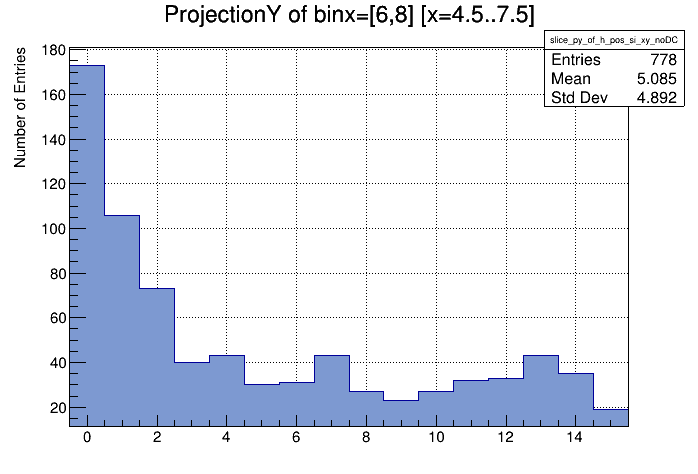
|
| Attachment 3: 124Xe_x-ray_35.png
|

|
| Attachment 4: 124Xe_x-ray_90.png
|
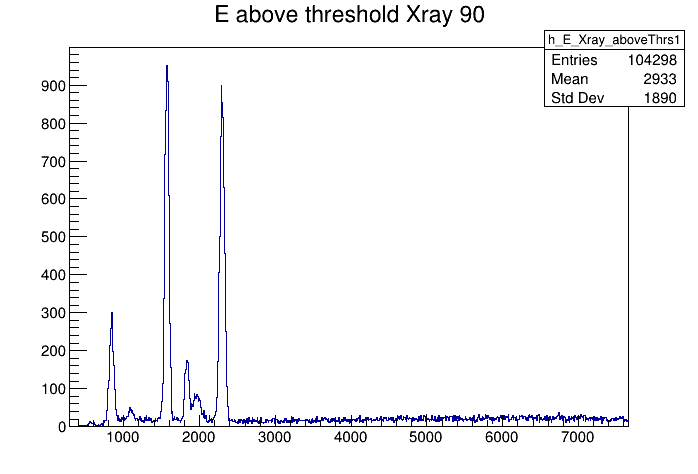
|
| Attachment 5: 124Xe_x-ray_145.png
|
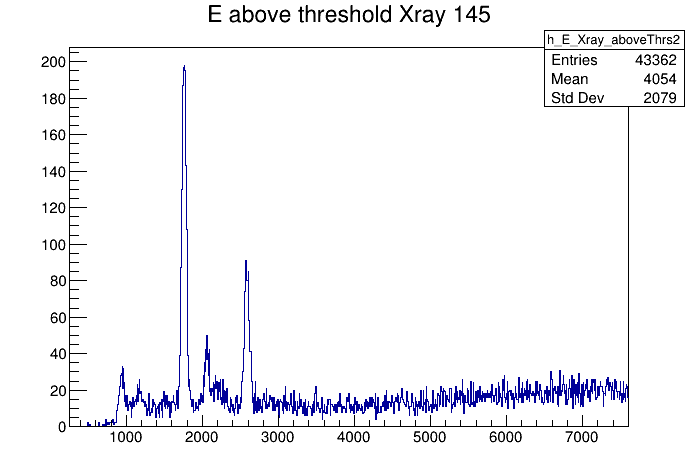
|
|
244
|
Mon Mar 23 13:26:59 2020 |
Jan | Analysis | runs_90to99 SCRAPER RESULTS | |
With scraper, we have roughly 150-200 (p,g) counts now.
X-rays look fine! |
| Attachment 1: 124Xe_Si_map.png
|

|
| Attachment 2: 124Xe_x-ray_35.png
|
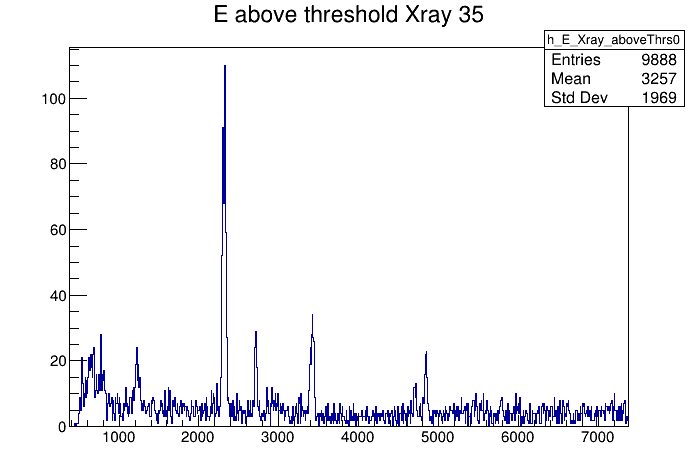
|
| Attachment 3: 124Xe_x-ray_90.png
|

|
| Attachment 4: 124Xe_x-ray_145.png
|

|
| Attachment 5: 124Xe_Si_projection.png
|

|
|
30
|
Thu Dec 5 10:57:57 2019 |
Jan, Laszlo | Detectors | setting up the DSSD with beam | |
This is a brief how-to about getting the DSSSD set up with stored beam and target in the ESR.
The main goals
1. adjust timing signals to TDC-range
2. adjust energy signals to ADC-range
3. optimize energy resolution
The signal chain is the following:
det [32ch.] > preamp [2x16ch] > 2x MSCF shapers [16ch] |
|
360
|
Fri May 21 01:17:37 2021 |
Laszlo | Analysis | simple analysis code | 2021 |
//a simple code (template) for offline analysis
//made by Laszlo, serves as a simple demonstration for enthusiastic shifters
//it creates a "no double counting Si 2D pos" histo
//usage:
//
//save the file as eg. "simple_code.c"
//root -l
//.L simple_code.c++
//run()
//when counter finished: ".q"
#define INPUT1 "input.root"//first unpack the lmd, then give the path of the unpacked .root file.
#define OUTPUT "./"//folder of the output. minimum input: "./"
#define ROOT_NAME "dummy.root"//name of the output
#include <cmath>
#include <string>
#include <sstream>
#include <cstdlib>
#include <cstdio>
#include <ctime>
#include <fstream>
#include <iostream>
#include <stdint.h>
#include "TROOT.h"
#include "TAttText.h"
#include "TAxis.h"
#include "TCanvas.h"
#include "TChain.h"
#include "TCut.h"
#include "TF1.h"
#include "TFile.h"
#include "TGraph.h"
#include "TGraphAsymmErrors.h"
#include "TGraphErrors.h"
#include "TH1.h"
#include "TH2.h"
#include "THistPainter.h"
#include "TKey.h"
#include "TLatex.h"
#include "TLegend.h"
#include "TMath.h"
#include "TMatrixD.h"
#include "TMinuit.h"
#include "TMultiGraph.h"
#include "TNtuple.h"
#include "TPave.h"
#include "TPaveText.h"
#include "TPoint.h"
#include "TRandom.h"
#include "TRint.h"
#include "TStyle.h"
#include "TString.h"
#include "TTree.h"
#include "TH1F.h"
#include "TH2F.h"
#include "TSystem.h"
#include "TProfile.h"
#include "TVirtualFitter.h"
#include "TCanvas.h"
#include "TLegend.h"
#include "TColor.h"
#include <time.h>
using namespace std;
inline bool exists_test0 (const std::string& name) {
ifstream f(name.c_str());
return f.good();
}
///////////////////////////////////////////////////////////////////////////////////////////////
void loop(TChain *fChain){
//setting pedestal values
int PEDESTAL_LOW=400;
int PEDESTAL_HIGH=8000;
//this normally should be in a separate header, branches are defined.
UInt_t trigger;
fChain->SetBranchAddress("TRIGGER",&trigger);
UInt_t E_SiY[17];
UInt_t E_SiX[17];
UInt_t t_SiY[17];
UInt_t t_SiX[17];
for(int a=1;a<17;a++){
fChain->SetBranchAddress(Form("E_SiY%d",a),&E_SiY[a]);
fChain->SetBranchAddress(Form("E_SiX%d",a),&E_SiX[a]);
fChain->SetBranchAddress(Form("t_SiY%d",a),&t_SiY[a]);
fChain->SetBranchAddress(Form("t_SiX%d",a),&t_SiX[a]);
}
//creating histos
TH2D *h_pos_si_xy=new TH2D("h_pos_si_xy", "h_pos_si_xy",16,0.5,16.5,16,0.5,16.5);
//creating and initializing some variables used in the event loop (for "no double counting")
int r_pos_x=0,r_pos_y=0;
int dc_Ex_max=-999;
int dc_Ey_max=-999;
Long64_t nentries = fChain->GetEntries();
Long64_t nbytes = 0;
//starting the entry loop
for (Long64_t i=0; i<nentries;i++){
nbytes += fChain->GetEntry(i);
//event countdown
if ((float(i)/100000.)==int(i/100000)){cout << "event: " << i << " \tof " << nentries << endl;}
if(trigger==1){//trigger 1 = TargetON
dc_Ex_max=-999;
dc_Ey_max=-999;
for(int i_x=1;i_x<17;i_x++){
for(int i_y=1;i_y<17;i_y++){
if( ((int)t_SiX[i_x])>0 && ((int)t_SiY[i_y])>0){
if( PEDESTAL_LOW<((int)E_SiX[i_x]) && PEDESTAL_HIGH>((int)E_SiX[i_x]) &&
PEDESTAL_LOW<((int)E_SiY[i_y]) && PEDESTAL_HIGH>((int)E_SiY[i_y])){
//assign the hit to StripX and StripY where the most energy is deposited (rel. Ecalibration is needed, but roughly ok)
if(dc_Ex_max<((int)E_SiX[i_x]) && dc_Ey_max<((int)E_SiY[i_y])){
r_pos_x=i_x;
r_pos_y=i_y;
dc_Ex_max=E_SiX[i_x];
dc_Ey_max=E_SiY[i_y];
}
}
}
}
}
//Filling pos. histo
if(dc_Ex_max!=-999 && dc_Ey_max!=-999){h_pos_si_xy -> Fill(r_pos_x,r_pos_y);}
}//trigger==1
}//entry loop
//writing out the root output file
TFile *graphfile = TFile::Open((OUTPUT + (string)("") + ROOT_NAME).c_str(), "RECREATE");
graphfile -> mkdir("map");
graphfile -> cd("map");
h_pos_si_xy -> Write();
graphfile -> Close();
}//loop
//////////////////////////////////////////////////////////////////////////////////////////////////////////////
void run(){
const char *command = new char[1000];
char filename[100];
TChain *fChain = new TChain("h101");
sprintf(filename,INPUT1);
if(exists_test0(INPUT1) && exists_test0(OUTPUT)){
cout<<"\033[0;37m//loading run: "<<filename << "\033[0m" <<endl;
fChain->Add(filename);
loop(fChain);
}
else{cout<<"\033[0;31mError 404: non-existing INPUT1 or OUTPUT file!\033[0m" <<endl;}
command = "rm *.so";
gSystem->Exec(command);
command = "rm *.d";
gSystem->Exec(command);
return;
}
int main(){
run();
return(0);
} |
|
22
|
Wed Sep 25 13:03:46 2019 |
Laszlo | Analysis | simulations on 118Te+p | |
I have made some simulations at 8AMeV, 7AMeV and 4AMeV energies for the main 118Te + p reaction channels. For the
Rutherford simulations credits to Yuanming! For each energy there are 3 simulations: without the scraper, with the
scraper (online), scraper (online) + E-truncation (offline). The scraper is treated as an "ideal scraper" meaning
that there is no scattering at the edges (maybe worth a GEANT4?). The slit position is at -3cm from the beam, the vertical
length is 7cm (centralized). The following channels are combined in the
simulation:
-8AMeV:
Rutherford
pg channel, 5cascade model. Photon emission is treated isotropically
pn channel, including: -->gs, -->1-->gs, -->2-->gs, -->3-->gs, -->3-->1-->gs, -->4-->1-->gs, -->5-->3-->gs,
-->5-->3-->1-->gs, -->5-->4-->1-->gs decay chains with their weights. Neutron and photon emission is treated isotropically.
-7AMeV:
Rutherford
pg channel, 4cascade model. Photon emission is treated isotropically
-4AMeV:
Rutherford
pg channel, 3cascade model. Photon emission is treated isotropically
The detector position is -2.5cm from the beam in the radial direction and centered vertically with a 45° tilt.
The cross section values for pg and pn, the pn channel mixing, and the pg cascade number is based on TALYS simulations.
The other two input parameters are the luminosity and the measurement time. For the simulation, a little
pessimistic (or realistic?) scenario is taken: L = 10^24 cm-2s-1, and t = 10^4 s. From this values, from the N=CS*L*t
equation, the pg counts (based on the TALYS
cross sections) are the following: 8AMeV ~267, 7AMeV ~163, 4AMeV ~5! This means that to reach the Gamow-window
energies is challenging, but with a well-working scraper it is not impossible to reach.
As it is visible, the 8AMeV 118Te(p,g) case is very similar to the 7AMeV 124Xe case. The p,n threshold is
somewhere ~7.5MeV. |
| Attachment 1: 118Te_cs_energy_line_.png
|
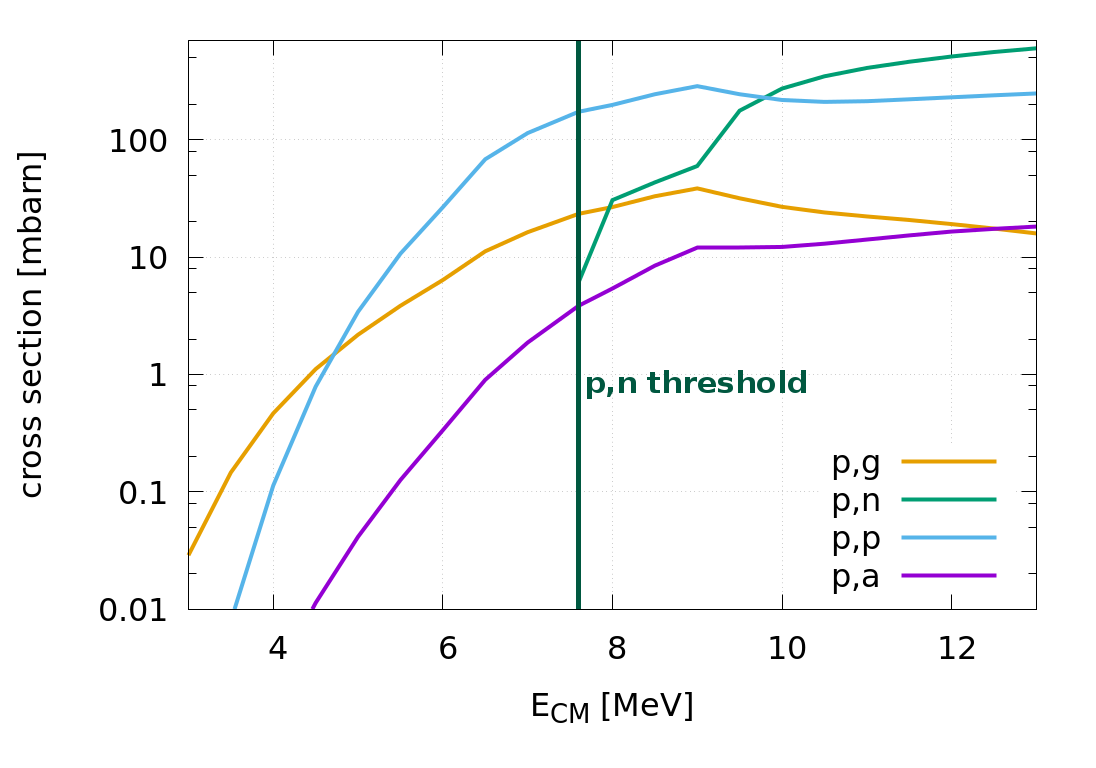
|
| Attachment 2: 8AMeV_combined.png
|
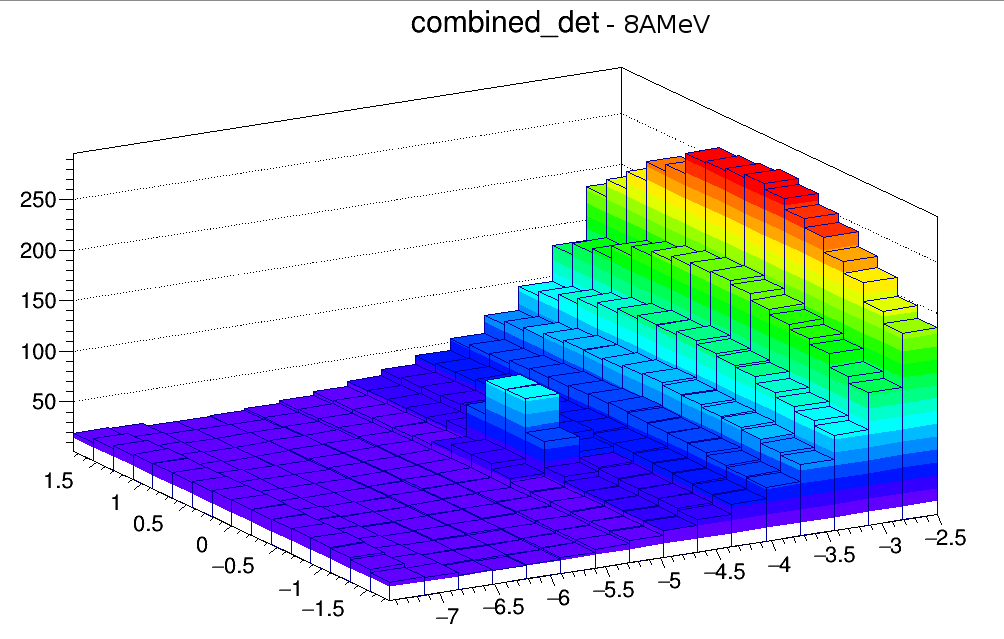
|
| Attachment 3: 8AMeV_combined_spectrum_withoutTruncation.root
|
| Attachment 4: 8AMeV_combined_spectrum_Truncation.root
|
| Attachment 5: 8AMeV_combined_spectrum_ETruncation.root
|
| Attachment 6: 7AMeV_combined_spectrum_withoutTruncation.root
|
| Attachment 7: 7AMeV_combined_spectrum_Truncation.root
|
| Attachment 8: 7AMeV_combined_spectrum_ETruncation.root
|
| Attachment 9: 4AMeV_combined_spectrum_withoutTruncation.root
|
| Attachment 10: 4AMeV_combined_spectrum_Truncation.root
|
| Attachment 11: 4AMeV_combined_spectrum_ETruncation.root
|
|
64
|
Thu Mar 19 15:09:29 2020 |
Jan | General | starting off with DSSSD | |
here is my short guide how to start with the measurement as soon as we have a beam available.
0. ESR timing in DAQ (maybe Uwe can also assist here)
- when the cycle is running already, even for tuning, you can try to make the cabling for ESR timing (jet ON/OFF)
- replace the gate generator signals by the ESR timing signals in the Messhütte and check UDP reader (E127_rates)
- the settings for ESR timing (event & machine) depend on the cycle, talk to Sergey or so, its the same settings as for the target in HKR
- with the current cycle this would be: ON-{machine 11, event 55}, OFF-{machine 13, event 55}
- the event for end of this process is alway 55
- if it works all tpat rates should be switching from upper to lower panel with the ESR cycle in the rate monitor (as they do now with the gate generator)
Once the tuning is finished:
1. optimize target ON/measurement time
- switch target to event and use the same machines/events as above
- check number of ions in ESR at ON and OFF and lifetime of beam
- we should measure for a drop of a factor of 3-4 roughly i would say
- e.g. start with 2e5 and stop with 5e4
- if we start with more, we can measure longer
1. without target, put in Si detector (GE01DD4AS in device controle) to max-in position
- see if it disturbs the ESR cycle (discuss optimization with ESR guys if necessary)
- we should also check vacuum in ring (i think this can be done remotely, ask Markus, Sergey or so)
2. make Si settings with beam (call me i can do things remotely)
- voltage to 60 volts, use E127_epics (i would expect the current at ~1uA, if no light source is close by)
- check picoscope for signals during entire cycle
- picoscope: (ch1: E_x ,ch2: Ex, ch4: gate)
- select central strip in y and 1st or 2nd x-strip as monitor output with epics (E127_epics > MSCF Si 1 & 2)
- if you don't get any at all, switch on target in measurement cycle (or permantely)
- still no nice signals? -> polarity is probably wrong, we need to switch MSCF of X and Y
- during our measurement period, the signals should be well below 10V (goal for reaction ions ~6V)
- adjust shaping time, gain, pole zero, threshold (epics) and Si-gate delay and length (e127.trlo) until you get nice histos
- if you see large rates at injection or decelleration, we should try to shield detector with the scraper
- put it as close as possible without disturbing the cycle, i.e. loosing more beam than without scraper
- we can also move it by event (e.g. move in or out on start or end of machines 4,6,11,12,13) depending on when it disturbs
3. find beam position at detector
- stop the cycle in SC 11
- try to scrape it away by moving the detector our with small steps
- you will need several injections, because if the short liftime, can get tedious
- follow instructions and numbers here: https://elog.gsi.de/esr/E127/37
4. last things
- ignore BaF for now
- check that x-rays are working, spectra okay? resolution?
- check rates during ON (x-rays: some 100 Hz each, Si: low, probably below 100Hz) and OFF (below 100Hz for all but BaF)
- check deadtime, do we need downscaling for any detector? (i would not expect this, BaF is downscaled already, don't worry)
5. first runs
- measure with and without scraper to confirm that Rutherford is under controle
- how long? > depends on the statistics
- try to see a clean effect of scraping, e.g. by the Si-plot E_ion vs x_position (Laszlo) |